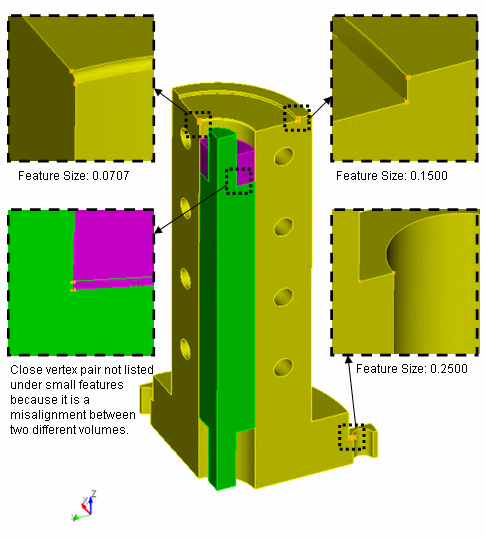
Cubit 16.06 User Documentation
The smallest feature size is a value that represents the size of the smallest detail in the volume that the user wants to include in the final mesh. Any details that are smaller than this size should be removed from the model before completing the other steps of the meshing process. Small details can result from a variety of different reasons. Sometimes the model contains excessive detail that the user does not need. Other times, small features such as extra curves are created during import to account for a mismatching topology. Still other times, the small features are the result of webcutting or other decomposition methods. Ideally there should be a minimum threshold at which the user decides to keep all features above the given size, and remove the rest. The smallest feature size is used for other diagnostic tools, so selecting an appropriate feature size is important for other steps in the mesh generation process.
After the Find Small Features button is pressed, Cubit lists the 10 closests vertex-vertex and vertex-curve pairs. The pairs are listed in the display window from smallest to largest. To see more pairs, change the search parameter in the input box. To visualize each pair, the user can right click on a feature and select the Draw Pair with Volumes option. After determining the smallest feature size the user can enter it in the edit field at the bottom of the panel and it will be used in later calculations. The user can also right click on one of the pairs in the list and choose Use as smallest feature to populate the edit field at the bottom of the panel.
The smallest feature check is only searching over vertex-vertex and vertex-curve pairs in the same volume. Small gaps and misalignments are not included in this list. The purpose of the small feature diagnostic panel is to search for features that need to be removed prior to meshing. A feature is an entity such as a small curve or sliver surface that exists on a single volume which must be resolved by the mesh. A gap or misalignment is two entities that should be coincident, but are not, due to translation or other problems. Gaps and misalignments may not hinder mesh generation on a given volume, but they do prevent proper imprinting and merging.
The imprint/merge, merge tolerance, and overlapping volume panels contain diagnostics that check for misalignment problems. The purpose of those diagnostics is to enable imprinting and merging of a volume with small misalignments.
Note: The smallest feature size is used as a metric on the merge tolerance page, but it is only used to get an initial estimate for the merge tolerance. Small feature size and merge tolerance represent different metrics, and should not be confused.
In Figure 1, the small feature size diagnostic finds small features with lengths of 0.707, 0.15 and 0.25. The user may decide that the smallest feature he or she wishes to keep is the one at the 0.25 size. If he sets the small feature size to 0.25, the other features will be flagged as small curves and surfaces on the Small Features page. They can then be removed using tweaking and other geometry clean-up commands. If he sets the small feature size to 0.707, none of the features will be flagged as small features.
In addition to the features shown, this model contains two vertices that are slightly misaligned due to geometry translation problems. The nearly coincident vertices are not listed on the small features list because the vertices lie on different volumes. To find these near coincident vertices, the user would use the merge tolerance panel.

Figure 1. Small Features and Overlap on a Model